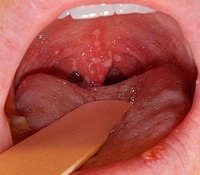Herpangina
| Herpangina | |
|---|---|
 |
|
| An example of herpangina in a child | |
| Classification and external resources | |
| Specialty | infectious disease |
| ICD-10 | B08.5 |
| ICD-9-CM | 074.0 |
| DiseasesDB | 30777 |
| MedlinePlus | 000969 |
| eMedicine | med/1004 article/218502 |
| MeSH | D006557 |
Herpangina, also called mouth blisters, is a painful mouth infection caused by coxsackieviruses. Usually, herpangina is produced by one particular strain of coxsackie virus A (and the term "herpangina virus" refers to coxsackievirus A) but it can also be caused by coxsackievirus B or echoviruses. Most cases of herpangina occur in the summer, affecting mostly children. However, it occasionally occurs in adolescents and adults. It was first characterized in 1920.
Symptoms include sudden fever with sore throat, headache, loss of appetite, and often neck pain. Within two days of onset an average of four or five (but sometimes up to twenty) 1 to 2 mm diameter grayish lumps form and develop into vesicles with red surrounds, and over 24 hours these become shallow ulcers, rarely larger than 5 mm diameter, that heal in one to seven days. These lesions most often appear on the tonsillar pillars (adjacent to the tonsils), but also on the soft palate, tonsils, uvula, or tongue.
A small number of lesions (usually 2 - 6) form in the back area of the mouth, particularly the soft palate or tonsillar pillars. The lesions progress initially from red macules to vesicles and lastly to ulcerations which can be 2 – 4 mm in size.
Typically spreads via the fecal-oral route or via the respiratory droplets.
Histologically, the epithelial cells show signs of intracellular and extracellular edema.
A diagnosis can be made from clinical signs and symptoms, and treatment consists of minimizing the discomfort of symptoms.
...
Wikipedia
